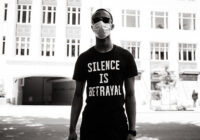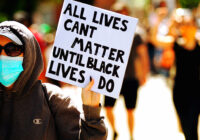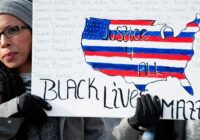A detailed look at the Sandra Bland case raises tens of questions about her arrest and death.
On July 10, the vibrant #BlackLivesMatter activist Sandra Bland was pulled over after changing lanes without using her turn signal. She was threatened and arrested by a police officer. Three days later on July 13, the 28-year-old was found hanging in her jail cell in Waller County, Texas. What followed was the usual cycle of spin: egregious vilification of her behavior and repeated deception of the public.
Unfortunately, we don’t have the time to investigate the 700 Americans killed by police this year—who are disproportionately black—or the five black women who died in jail over two weeks in July. Yet a look at Bland’s case highlights major inconsistencies shared through an all-too-common communications strategy.
Early accounts described her as pulled over for illegally changing lanes, “very combative” and “depressed” and “not a model person.” Such smear narratives are used to blame virtually all African Americans who are brutalized and slain by police. “It’s their fault,” we’re told in many ways. But for their bad attitudes, violent (off-camera) behavior, drug use, mental health problems or business activity they would be thriving. It’s a competing narrative to the common quote: “There, but for the grace of God, go I.”
That’s the essence of oppression: An unwillingness to remake racist institutions and challenge racist behavior. Instead, the oppressed are told to walk an impossibly thin line, even as others coast down on a four-lane highway of freedom, flaunting “mistakes.” In contrast, many minorities follow the law and then fearfully forgo their rights, an easy-to-understand approach, albeit one that does not challenge change in a culture of abuse by the powerful. Yet even in many cases where blacks break no laws, they still suffer greatly. Because it was never about them. It was about a false construction of race to justify racist actions.
The full truth of what happened to Sandra Bland is not known. But what we do know should outrage us into demanding answers and accountability.
WHY WAS SHE TARGETED FOR A TRAFFIC STOP?
First, we were told she improperly changed lanes, a seemingly minor, common offense. Yet the video released (the second from the cop’s dashcam) debunked that improbable story. It showed Trooper Brian Encinia making a U-turn and quickly driving up behind her. In response, Bland rapidly changed lanes without signaling to allow him to pass. A recent conversation with a police representative indicates this behavior—not signaling and waiting to change lanes—is the correct response.
WHICH VIDEO IS ON HER CELLPHONE, AND WHY WAS SHE MADE TO STOP RECORDING?
The #BlackLivesMatter activist, whose informative and passionate video blog Sandy Speaks discusses police brutality, taped the encounter. In the police dashcam video, she is told to put down her cellphone as she is being walked off camera. She says, “I’m not on the phone, I have a right to record this.” She is made to put her phone down.
WHY DOES THE COP THINK HE CAN GET AWAY WITH DENYING HER RIGHTS?
After Bland is pulled over, she smokes a cigarette. Encinia tells her to get out of the car, but she refuses, knowing her rights. He then tries to pull her out of the car, tells her he is going to “yank” and “drag” her out, before threatening to taser her (“light her up”).
Bland is beaten, out of visual range of his dashcam, although another bystander did capture cell phone video. The passer-by too was (illegally) told to stop filming. His or her video shows Bland saying, “You slammed my head into the ground. Do you not even care about that?” She also says he is about to break her wrist and that she can’t hear (consistent with a concussion).
WHY DOES THE POLICE DASHCAM APPEAR TO BE ALTERED?
The police dashcam video was clearly edited. Why, and where is the original footage? Also why would she, an expert on police violence, have come out with a hand up and a resigned attitude and then be taken out of the range of the camera? Why would she have supposedly kicked the officer when she was taken out of range of the police camera (unless he was badly hurting her, as the dashcam transcript supports)?
WHY WAS SHE ARRESTED?
We were told early on that Bland was arrested for resisting arrest. But in fact, the police officer tells her she is under arrest while he is inexplicably trying to drag her out of the car (video at 10:10). Bland then asks why she is being arrested repeatedly, but Encinia refuses to answer, continuing to shout at her to get out of the car.
Later the officer must have realized this made no sense: What was she being arrested for in the first place? For moving her car out of way of a cop that was tailing her?
So then we were told that she was arrested for assaulting a police officer (which occurred off-camera, unsurprisingly). But even that story was inconsistent. The officer reported she was put down because she kicked him (also on dashcam video) and conversely signed an affidavit saying she swung her elbows and kicked him after being handcuffed (seemingly impossible, even more so after being injured).
How could she be arrested for something she did after he handcuffed her? And why would she be placed in handcuffs in the first place? Why was she ordered to exit her car? And, in that circumstance, shouldn’t she have vociferously argued with someone who was arresting and beating her over nothing? Doesn’t much of the media, which has been extremely critical over Bland’s attitude, owe her an apology?
WHY ARE HER ISSUES EXAGGERATED?
Much was made of Sandra Bland having a Facebook post in which she mentioned that she was suffering from “a little bit of depression as well as PTSD” that “affect everyone” (the latter affects a whopping one in ten women). But in that same video, she reaffirms her commitment to share her love with her community and expounds on her belief in a comforting God. Indeed, much of that video, like so many others of hers, is filled with her luminous smile.
Her family and friends reaffirm this optimism, including her excitement about the new job she was about to start at her alma mater and their belief that she did not kill herself.
Close to her last words in jail were a request for instructions on how to make a phone call, which she did not make. Why did she not make this telephone call, after making numerous other calls? Her last words exchanged in person appear to be, “I’m fine,” spoken to a jailer at 7:05am on July 13. At 8:55am, she was found dead.
Perhaps the most haunting and telling words were those exchanged during her illegal traffic stop. “I can’t wait till we go to court,” she said to Trooper Encinia, clearly reveling in the idea of having her story heard. She repeated variations of this six times during her arrest. Now, of course, she won’t get her day in court.
WHY ARE THERE DISCREPANCIES ON HER ENTRY FORM AND PROCESSING?
Why was Bland’s mug shot of her in an orange uniform, when individuals are photographed in street clothes? Is the jail video of her (the woman appears heavier), and how can this be verified?
Conflicting information was provided on a previous suicide attempt, whether she was suicidal and whether she took epilepsy medication. Why weren’t these discrepancies resolved, assuming they were truly written by her? Why was Bland placed on hourly checks—although she should have been on 15-minute face-to-face checks—were she really assessed as suicidal? Also in this case, why was she given a single cell rather than sharing one? Additionally, did the jail personnel ensure she received her epilepsy medication to prevent a seizure?
WHY WASN’T SHE BAILED OUT?
We’re so far into what should not have happened. But Sandra Bland made a call to a bail bondman and her family tried to bail her out. Why wasn’t she able to post bond and get released from jail quickly?
HOW CREDIBLE IS HER “SUICIDE,” LOGISTICALLY?
Sandra Bland supposedly hung herself in her cell using a trash bag on a partition shorter than her. How exactly would she have accomplished this? Why was she not checked for more than an hour right before her death, despite a requirement for hourly checks?
Four people have been said to have killed themselves in that jail of a county, which has a population of only 40,000. The last one also supposedly assaulted a police officer. His death prompted an inquiry into why he did not receive a scheduled check.
WHAT’S BEHIND THE FLAWED AUTOPSY AND TOXICOLOGY REPORT?
THC was found in Bland’s blood in the toxicology report, resulting in claims she was high, leading to her suicide (a dubious link). More importantly, little can be concluded from the initial autopsy report as it tells “nothing about impairment”—it is (euphemistically) an interesting distraction. The first autopsy showed no evidence of “violent homicide,” which was spun to say it showed she committed suicide. But couldn’t she have been easily subdued in her jail cell and killed if she was unsuspecting?
Also, the lack of evidence of a violent homicide does not rule out other causes of death, including those resulting from a concussion or a seizure. Have those possibilities been eliminated and how? Does examination of her body prove that she was not asphyxiated? Did the autopsy specifically prove or support the assertion she hanged herself, and was this the cause of her death? How?
Additionally, how could there have been the plant matter found in her back, given that she was wearing a maxidress and placed on her stomach with a knee in her back? The family was told the first autopsy was flawed and that they may have to do another one. Why? Will further studies be done by an independent group? What might they show and how?
WHAT’S GOING ON IN WALLER COUNTY TEXAS?
“This is probably [the] most racist county in the state of Texas which is probably one of the most racist states in the country,” said DeWayne Charleston, a former Waller County judge, in 2007. Waller County Sheriff Glenn Smith was suspended from his Texas police chief job after allegations of racism were made, and he was fired after accusations of humiliating strip searches of young African Americans. He was elected as sheriff that year and re-elected the year that a black man was found dead in his jail cell.
Trooper Brian Encinia was cited for “unprofessional conduct” within a year of being on a job, and his traffic stop of Sandra Bland was supported by his bosses.
WAS IT A HATE CRIME?
The entire police incident (and the contrast with the one at the beginning of the dashcam video) makes it clear that Sandra Bland was illegally targeted and arrested. Is what happened—a crime involving threats, harassment and/or physical harm—motivated in part or in whole by her identity? What specifically motivated the police officer to pull her over? Was it her race, her gender, a combination or her activism? What prompted him to arrest and beat her?
Bland called out Encinia during this violence, recognizing it as a power play over a woman, an attempt to take out his aggression against her in a way that wouldn’t be prosecuted. Is there evidence of his watching videos, like violent pornography, participating in chats or sending mails that indicate a racist or misogynist ideology? Are there others who have been mistreated by him?
Various “conspiracy” theories exist, some of which have been discredited. But their existence—faulty though they may be—represents an understanding of the inconsistencies in a communications strategy of piecemeal, inconsistent statements that try to blame Sandra Bland for her suffering and death. The approach used by the state dehumanizes and disrespects her, while patronizing the American public.
On April 8, Sandra Bland posted a photo on Facebook of a black man being hung by an American flag. The eerie precursor to her own death is also a statement on how such violence is culturally and politically permissible, a theme echoed in so much of her work comprising a stirring legacy.
“You don’t know racism because you don’t live it. You don’t feel it,” Bland said in a haunting video post. Her life and death must be an irrepressible call to action which proves that even if we haven’t experienced her reality, we’ve adopted her sense of urgency on these issues.
We must support policies and actions to eliminate racism in policing institutions, to include federal government investigations. We must support the efforts of her family who have filed a lawsuit against the officer and called for a Justice Department investigation. We must illuminate all aspects of this case and ensure justice is served to the fullest extent that it is truly possible.
But more importantly, we must come out of our identities and speak up like Sandra Bland. We must make it our work to end the culture of violent policing in America. We owe it to her, and to ourselves, to construct what could be the dream of America through our speech and activism.
The views expressed in this article are the author’s own and do not necessarily reflect Fair Observer’s editorial policy.
Photo Credit: A Katz / Shutterstock.com
 We bring you perspectives from around the world. Help us to inform and educate. Your donation is tax-deductible. Join over 400 people to become a donor or you could choose to be a sponsor.
We bring you perspectives from around the world. Help us to inform and educate. Your donation is tax-deductible. Join over 400 people to become a donor or you could choose to be a sponsor.
Support Fair Observer
We rely on your support for our independence, diversity and quality.
For more than 10 years, Fair Observer has been free, fair and independent. No billionaire owns us, no advertisers control us. We are a reader-supported nonprofit. Unlike many other publications, we keep our content free for readers regardless of where they live or whether they can afford to pay. We have no paywalls and no ads.
In the post-truth era of fake news, echo chambers and filter bubbles, we publish a plurality of perspectives from around the world. Anyone can publish with us, but everyone goes through a rigorous editorial process. So, you get fact-checked, well-reasoned content instead of noise.
We publish 2,500+ voices from 90+ countries. We also conduct education and training programs
on subjects ranging from digital media and journalism to writing and critical thinking. This
doesn’t come cheap. Servers, editors, trainers and web developers cost
money.
Please consider supporting us on a regular basis as a recurring donor or a
sustaining member.
Will you support FO’s journalism?
We rely on your support for our independence, diversity and quality.









Comment